Clipart tagged: ‘pendulum’

Deadbeat Escapement
A piece in clocks and watches that converts rotational motion into oscillation, as in a pendulum.

Recoiling Escapement
A piece in clocks and watches that converts rotational motion into oscillation, as in a pendulum.

Bloxam's Gravity Escapement
A gravity escapement uses a small weight or a weak spring to give an impulse directly to the pendulum.…
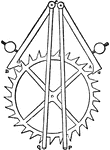
Mudge's Gravity Escapement
A gravity escapement uses a small weight or a weak spring to give an impulse directly to the pendulum.…
Henleys Electrometer
"The electrometer of Henley, sometimes called Henley's quadrant Henley electrometer, may be taken as…
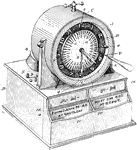
Memograph Clock
A Memograph is a clock that is designed to make a loud sound at a specific time. The primary use of…
Pendulum
"A pendulum has a strong tendency to maintain its plane of oscillation, a fact that has been used in…
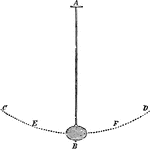
Pendulum
"A pendulum consists of a heavy ball suspended in such a way as to swing to and fro." —Quackenbos…

Ballistic Pendulum
"From a cross piece, A, on a stout framework, a heavy block of wood, B, is suspended, in such a way…
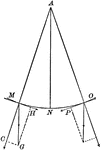
Motion of a Pendulum
"When the pendulum is drawn from its vertical position, the force of gravity, MG, is resolved into two…
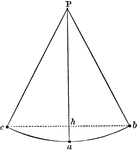
Path of a pendulum
"When the pendulum hands at rest in a vertical position, as Pa, it has no energy at all. Considered…

Torsional Pendulum
"Firmly fasten one end of a piece of spring-brass wire, about No. 27 and about 1 m. long so that the…
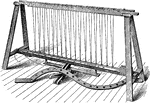
Line of pendulums
"An apparatus devised by Mach for the illustration of the pendular motions of the particles of a medium…

Quarter Clock
"The front view of a large quarter clock of Sir E. Beckett's design, with all the wheels on the great…

Sine Electrometer
"The sine electrometer of August, is a modification of the single pendulum electroscope, analogous in…
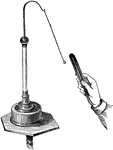
Demonstration of Static Electricity
A hand with bar demonstrating the attractive properties of static electricity.
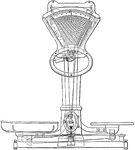
Price Computing Weighing Machine
An illustration of a price computing weighing machine using an even even balance and pendulum.


